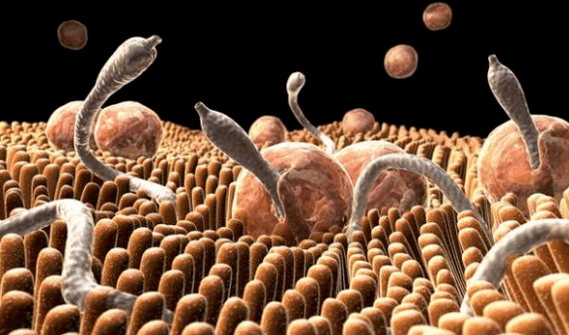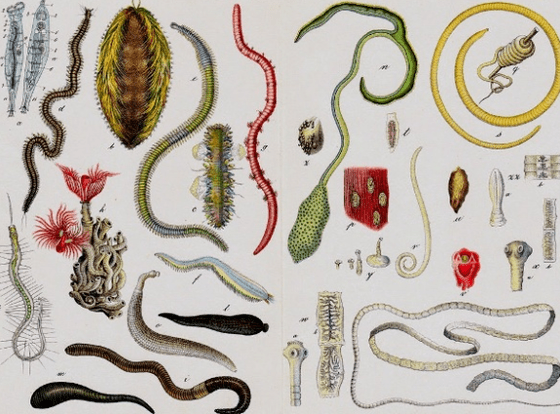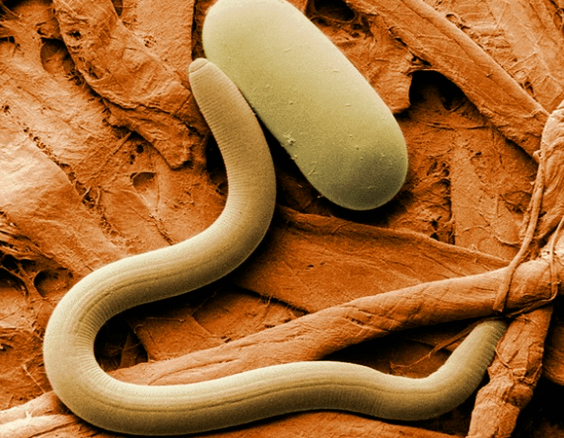Parasites are organisms that exist at the expense of the owner.Their vital activity in the human body can occur asymptomatic.Therefore, the helminth invasion is one of the most rarely diagnosed pathologies.

Parasitic diseases lead to serious consequences.According to the World Health Organization, they cause the death of 16 million people worldwide.In order to find the parasite in a timely manner and prevent complications, you need to know about the possible ways of infection and symptoms.
Why are parasites dangerous?
Parasites can live on both the body and within a person.Some of their varieties are not dangerous, while others pose a serious threat to life.Helminest Life products have a toxic effect.With great accumulation, body poisoning occurs.
Symptoms of parasite intoxication:
- vomiting;
- weakness;
- loss of appetite;
- high body temperature;
- fever;
- Convulsions.
Treatment should be started on time as the neglected condition can lead to death.
The effects of parasitic infection differ depending on the localization of the parasite.Worms can cause an allergic reaction, blindness, paralysis, destroy the liver, lungs, brain, affect the functioning of other organs.They reduce immunity, which is why a person is more susceptible to infectious diseases.
The most dangerous parasites:
- Brain amoeba (tape)SHe lives in the brain, the life span of up to 20 years.As the tape grows, he strives to kill his master.Mortality occurs in 97% of cases.The worm causes cerebral edema and the infection is possible with the use of infected meat or water.
- AskaridsSRinging worms that are common in the child's body.Adults grow up to 30 cm in length.Symptoms of general intoxication occur and you can become infected through dirty hands.
- OnhocarcavelosSA worm that causes river blindness (onchocent).
- TripanosomaSCauses chronic diseases of the heart and intestines.
- Australian miteSIt causes a severe allergic reaction, leading to respiratory failure.
Common symptoms
The most common signs of parasites are allergic manifestations in the form of urticaria, itching of the skin, rashes, fever and attacks of bronchial asthma.
General symptoms of parasitosis in the body:
- nausea, vomiting;
- abdominal pain;
- stool disorder (diarrhea or constipation);
- itching in the anus;
- Grinding teeth in a dream;
- deteriorating appetite;
- headache;
- weakness, fatigue;
- vitaminosis;
- reduction of immunity;
- anemia;
- cough;
- joint or muscle pain;
- A sharp decrease or increase in body weight.
Symptoms may not appear immediately.For example, clinical signs when infectious pinari appear after 2-3 days and ascaris after 3 months.
Types of parasites
Parasites in the human body can live anywhere.They can usually be found in the intestine and liver, but they can parasitize in the lungs, muscle tissue, blood, blood vessels and brain.If the larva falls into the blood, then it can be attached to any internal organ, disrupting its function.
What parasites live in the human body?There are more than 250 species that can live at the expense of a person.Their sizes range from microscopic to meters, the number may also be different.
The main types of parasites in humans can be distinguished:

- Ectoparasites;
- Helminths;
- Protozoal.
Ectoparasites
This species lives on the skin.Representatives of ectoparasites:
- Head of waves, shameful and salaries - pediculosis;
- The bed is a carrier of infectious diseases such as hepatitis, tuberculosis and typhoid fever;
- Demodecosis;
- Scab - scabies;
- Cochliomyia - cochliomias.
Parasite infection occurs through a contact house.They are transmitted with bodily contact, through personal hygiene objects and clothing.Kochliomyes occur when flies that are common in North and Central America.
The simplest parasites
The following parasites belong to them:
- In the intestine - amebies, Jardia, Lishmania, Balstocysts, Blanditia;
- In the blood - tripanosomes, Babesia;
- In the organs of the geniopolous system - Trichomonas;
- In the internal organs (heart, lungs, liver, brain) - toxoplasms, tripanosomes, acanhamoebas.
The infection occurs through food, water, sexual contact (in the case of trichomonad).
Helminth
These are worms that in the process of their lives disrupt the work of the internal organs and metabolism.The worms can only be a few inches in length or reach 7-10 m.
With the primary infection, they are found in the intestine and with repeated other organs and muscles can affect.Most often there are worms that live in the rectum, liver, biliary tract and lungs.
The most common diseases caused by helminth parasites:
- AcaridosisSThe larvae pass through the digestive tract and settle in the intestine.An adult reaches 25-30 cm.
- OpistorchozSAdults affect the bile ducts, enter the human body with the infected fish.
- CestodosisSThe infection caused by ribbon worms occurs in a person through meat and fish, the intestines are affected.
- ShostsomosisSIt is caused by plates or flat worms.The infection occurs when the skin of the water infected with freshwater snails.
This type includes a large number of subspecies.A total of more than 300 varieties of helminths have been registered.
They can be grouped into 3 groups:
- Nematodes - roundworms;
- Trematodes - plates;
- Castodi - red worms.
Nematodes
The most conventional representatives of roundworms:
- Pinworms;
- Ascarids;
- Blakoviv.
The main ways to infection with helminths are the use of dirty products or contaminated water, unwashed hands, insect bites.Nematodes are established in the gastrointestinal organs, rarely in the liver, lungs and heart.
The main symptoms of the presence of parasites in the human intestine:
- nausea, vomiting;
- itching in the anus;
- skin rashes;
- poor digestion;
- Chronic fatigue.
With a large population, the parasites come out of the body naturally.In this case, the nematode can be found in the stool.
Trematodes
They lead to dangerous infectious diseases.These parasites, depending on the habitat, can be divided into such groups:
- Blood bars - schistosomes;
- Tremony of liver liver bikars;
- intestinal plates;
- Pancreatic parasites;
- Pulmonary loss.
Symptoms of infection depend on the affected organ.This can be weakness, dizziness, impaired appetite, nausea, stool disorders, pallor of the skin, irritability or apathy.
The main source of infection is to obtain excrement of sick animals or people in water and soil.
Cestodi
The rough worms live in the intestine.They fall into the human body when using meat and fish insufficiently processed sufficiently processed.The biggest danger is the pig chain, which can migrate in the blood, muscle tissue and the brain.
Castods can parasitize in the body for a long time without obvious signs growing to impressive size.The length of the adult is up to 10 m.General diseases caused by cestodi - vitellinus, echinococcosis.
Ordinary representatives of the cestodes:
- tape;
- Bull and pork tapeworm;
- shepherd's brain;
- Echinococcus.
Which doctor to contact parasites?
Parasitic diseases are treated by parasitologists.They should be associated with suspicion of infection.The dermatologist can also find parasites on the skin.
Diagnostics
The diagnosis of parasitic worms is carried out using a laboratory examination of the stool.To determine the worms, you must do the analysis three times.
The cutter parasites are detected by scraping, which is done by adhesive tape.It is possible to check for parasites that do not participate in digestion using a blood test or biopsy.
Treatment
You can clear the human body from parasites with the help of medicines and folk remedies.The duration of treatment depends on the degree of infection and intoxication of the body.
Treatment of drugs of parasites
Helminthiasis treatment involves the use of antelmintic agents.They are toxic, so it is impossible to use them without a confirmed diagnosis.Symptoms of helminthiasis are stopped using symptomatic treatment.Vitamin preparations, choleric drugs, hepatoprotectors, laxative, anti -allergic drugs, antibiotics, probiotics are used.In severe allergic reactions, corticosteroids are prescribed.
Folk treatment of parasites
You can get rid of parasites in the human body with the help of such means of traditional medicine:
- CranberrySIt helps to get rid of helminths and protozoa.For 2 liters of water you should take 2 s. L. L.Cranberry juice and 1 tbsp.l.Salt.Do the procedure 2 times a day.
- Garlic enemaSThis way you can get rid of the intestinal parasites - boil 6 cloves of garlic in 1 liter of milk, cooling and make an enema.
- Pumpkin seedsSPurified seeds (300 g) should be lubricated, pour a small amount of water, add 100 g of honey.Eat in a meeting with a laxative.
- Onion infusionSCut the large onion into pieces, pour boiling water, leave for 12 hours.Drink 100 g 3-4 times a day.

In order to remove parasites from the stomach and intestines, it is necessary to eat spicy foods.Using garlic, onions, sharp spices and spicy herbs, you can easily get rid of Pinworms.
Complications
Parasites negatively affect the human body.If Helminthosis is not treated, severe complications occur:
- frequent SARS, increased adenoids and tonsils;
- appendicitis;
- enteritis, gastroenteritis, enterocolitis;
- cirrhosis;
- Liver cancer;
- anemia;
- gastrointestinal bleeding;
- pancreatitis;
- bronchitis;
- oncological diseases;
- cerebral edema;
- Purulent septic lesions.
The vital activity of parasites in the abdomen leads to peritonitis, in the lungs - to pneumonia.Askarides clogs the respiratory and bile ducts, provoke suffocation or intestinal obstruction.
Prevention
Preventive measures against parasite infection:
- Wash your hands before eating and after the street;
- Use only washed vegetables and fruits, boiled water;
- Keep food in accordance with sanitary standards, avoid contact with flies;
- Consume meat and fish only after heat treatment;
- Do not bathe in contaminated tanks;
- Do not use other people's hygiene products;
- Perform presser pets.
Although worms are a threat to human health and life, the body cleanses the body only after the detection of parasites and under the supervision of a doctor.Timely diagnosis of helminthiasis will avoid severe complications.It is important to take preventative measures, especially in children.


















